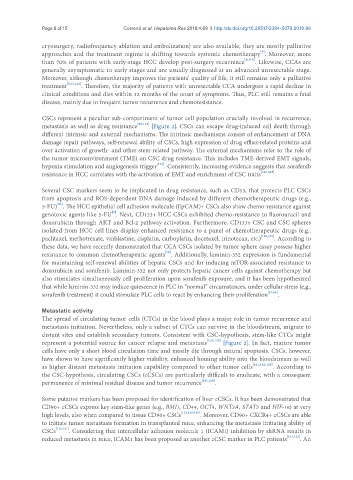Page 771 - Read Online
P. 771
Page 6 of 15 Correnti et al. Hepatoma Res 2018;4:69 I http://dx.doi.org/10.20517/2394-5079.2018.96
cryosurgery, radiofrequency ablation and embolization) are also available, they are mostly palliative
[9]
approaches and the treatment regime is shifting towards systemic chemotherapy . Moreover, more
than 70% of patients with early-stage HCC develop post-surgery recurrence [9,110] . Likewise, CCAs are
generally asymptomatic in early stages and are usually diagnosed at an advanced unresectable stage.
Moreover, although chemotherapy improves the patients’ quality of life, it still remains only a palliative
treatment [5,13,120] . Therefore, the majority of patients with unresectable CCA undergoes a rapid decline in
clinical conditions and dies within 12 months of the onset of symptoms. Thus, PLC still remains a fatal
disease, mainly due to frequent tumor recurrence and chemoresistance.
CSCs represent a peculiar sub-compartment of tumor cell population crucially involved in recurrence,
metastasis as well as drug resistance [86,121] [Figure 2]. CSCs can escape drug-induced cell death through
different intrinsic and external mechanisms. The intrinsic mechanisms consist of enhancement of DNA
damage repair pathways, self-renewal ability of CSCs, high expression of drug efflux-related proteins and
over activation of growth- and other stem-related pathway. The external mechanisms refer to the role of
the tumor microenvironment (TME) on CSC drug resistance. This includes TME-derived EMT signals,
[122]
hypoxia stimulation and angiogenesis trigger . Consistently, increasing evidence suggests that sorafenib
resistance in HCC correlates with the activation of EMT and enrichment of CSC traits [123-125] .
Several CSC markers seem to be implicated in drug resistance, such as CD13, that protects PLC CSCs
from apoptosis and ROS-dependent DNA damage induced by different chemotherapeutic drugs (e.g.,
[86]
5-FU) . The HCC epithelial cell adhesion molecule (EpCAM)+ CSCs also show chemo-resistance against
[9]
genotoxic agents like 5-FU . Next, CD133+ HCC CSCs exhibited chemo-resistance to fluorouracil and
doxorubicin through AKT and Bcl-2 pathway activation. Furthermore, CD133+ CSC and CSC spheres
isolated from HCC cell lines display enhanced resistance to a panel of chemotherapeutic drugs (e.g.,
paclitaxel, methotrexate, vinblastine, cisplatin, carboplatin, docetaxel, irinotecan, etc.) [126,127] . According to
these data, we have recently demonstrated that CCA CSCs isolated by tumor sphere assay possess higher
[70]
resistance to common chemotherapeutic agents . Additionally, laminin-332 expression is fundamental
for maintaining self-renewal abilities of hepatic CSCs and for inducing mTOR-associated resistance to
doxorubicin and sorafenib. Laminin-332 not only protects hepatic cancer cells against chemotherapy but
also stimulates simultaneously cell proliferation upon sorafenib exposure, and it has been hypothesized
that while laminin-332 may induce quiescence in PLC in “normal” circumstances, under cellular stress (e.g.,
sorafenib treatment) it could stimulate PLC cells to react by enhancing their proliferation [17,86] .
Metastatic activity
The spread of circulating tumor cells (CTCs) in the blood plays a major role in tumor recurrence and
metastasis initiation. Nevertheless, only a subset of CTCs can survive in the bloodstream, migrate to
distant sites and establish secondary tumors. Consistent with CSC-hypothesis, stem-like CTCs might
represent a potential source for cancer relapse and metastasis [121,128] [Figure 2]. In fact, mature tumor
cells have only a short blood circulation time and mostly die through natural apoptosis. CSCs, however,
have shown to have significantly higher viability, enhanced homing ability into the bloodstream as well
as higher distant metastasis initiation capability compared to other tumor cells [121,122,128] . According to
the CSC-hypothesis, circulating CSCs (cCSCs) are particularly difficult to eradicate, with a consequent
permanence of minimal residual disease and tumor recurrence [121,128] .
Some putative markers has been proposed for identification of liver cCSCs. It has been demonstrated that
CD90+ cCSCs express key stem-like genes (e.g., BMI1, CD44, OCT4, WNT3A, STAT3 and HIF-1α) at very
high levels, also when compared to tissue CD90+ CSCs [121,129,130] . Moreover, CD90+ CXCR4+ cCSCs are able
to initiate tumor metastasis formation in transplanted mice, enhancing the metastasis initiating ability of
CSCs [121,131] . Considering that intercellular adhesion molecule 1 (ICAM1) inhibition by shRNA results in
reduced metastasis in mice, ICAM1 has been proposed as another cCSC marker in PLC patients [121,132] . An

